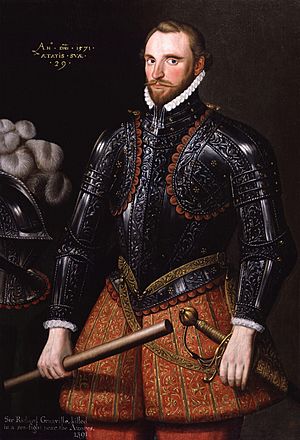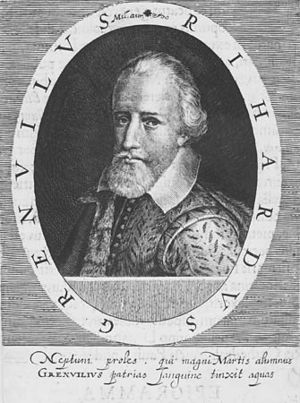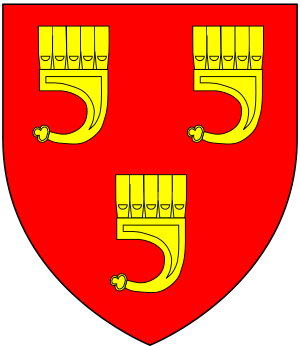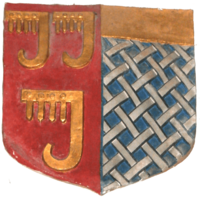Richard Grenville facts for kids
Quick facts for kids
Sir Richard Grenville
|
|
|---|---|

A portrait of Sir Richard Grenville from 1571, when he was 29 years old. National Portrait Gallery, London.
|
|
| Born | 15 June 1542 Bideford, Devon, England |
| Died | 10 September 1591 (aged 49) Flores, Azores Islands |
| Allegiance | |
| Service/ |
|
| Rank | Admiral |
| Commands held | Revenge |
| Battles/wars | Second Desmond Rebellion Anglo–Spanish War (1585) Battle of Gravelines Battle of Flores (1591) |
| Spouse(s) | Mary St Leger |
| Relations | Son Bernard Grenville |
Sir Richard Grenville (born June 15, 1542 – died September 10, 1591) was an English explorer, privateer, and military leader. He was known for his bravery and his role in England's early efforts to explore and settle new lands. Grenville owned large estates in Stowe, Cornwall and Bideford, Devon. He took part in the English settlement of Ireland, helped with the English colonies in America, and defended England against the Spanish Armada.
Grenville also served as a Member of Parliament for Cornwall and held important local positions like High Sheriff of County Cork and Sheriff of Cornwall. In 1591, he died heroically at the Battle of Flores near the Azores Islands. His ship, the Revenge, fought a much larger Spanish fleet to allow other English ships to escape. Sir Richard Grenville was the grandfather of Sir Bevil Grenville, who became a famous military officer during the English Civil War.
Contents
Who Was Richard Grenville?
Richard Grenville was the oldest son of Sir Roger Grenville, who was a captain of the ship Mary Rose when it sank in 1545. His mother was Thomasine Cole. The Grenville family was very old and important, owning lands in Bideford and Stowe, Kilkhampton. Richard was also a cousin of famous figures like Sir Walter Raleigh and the explorer Humphrey Gilbert.
Richard was born in Bideford. His father died when Richard was only three years old. His mother then married Thomas Arundell, and Richard spent much of his childhood at Clifton Arundell House. When he was 17, Richard began studying law.
Early Life and Marriage
In 1562, when he was 20, Richard was involved in a fight in London. He was later pardoned for this incident. At 21, he inherited his grandfather's estates in Stowe, Bideford, and Buckland Abbey. Around 1565, he married Mary St Leger. He was appointed High Sheriff of Cork in Ireland in 1568.
Military Adventures
Fighting in Hungary
Richard Grenville had a strong interest in military life. In 1566, he traveled to Hungary with other English gentlemen from the West Country. They fought against the Turks for the Holy Roman Emperor, Maximilian. Grenville and his companions paid for and recruited their own soldiers to join this campaign.
Activity in Ireland
In 1569, Grenville went to Ireland to help settle lands in the area of Kerricurrihy. He also took lands for English settlement at Tracton. These efforts to establish English control in southern Ireland led to conflicts with local Irish leaders. These conflicts grew into the Desmond Rebellions, led by James Fitzmaurice Fitzgerald.
As Sheriff of Cork, Grenville saw the rebellion firsthand. Fitzmaurice and his allies attacked Tracton, defeating the English defenders. They also plundered the city of Cork. The rebellion continued, but Grenville returned to England.
Back in England
In 1571, Grenville was elected as a Member of Parliament for Cornwall. He was also appointed High Sheriff of Cornwall in 1576. He was a strong supporter of the Protestant faith.
Buckland Abbey Home
Between 1575 and 1576, Sir Richard returned home to Bideford. He expanded his properties and businesses. He also finished remodeling Buckland Abbey to make it a comfortable home for his family. He decorated it with themes related to sailing and his family's coat of arms.
Developing Bideford Port
Grenville played a big part in making Bideford, a small fishing village in North Devon, into an important trading port. This port later became known for importing tobacco from the new American colonies. In 1575, he officially created the port of Bideford. The Grenville family had been the "Lords of the Manor" of Bideford since 1126. Richard Grenville helped establish the town council, and his family later gave up their title to the council in 1711. He was again elected as a Member of Parliament for Cornwall in 1584.
Efforts in the New World
In 1585, Grenville led a fleet of seven ships that carried English settlers to establish a colony on Roanoke Island. This island is off the coast of what is now North Carolina in North America. Before leaving, Grenville reacted strongly when a silver cup went missing from the colony. He and his men attacked and burned the nearby village of Aquascogoc.
On his way back to England, Grenville captured a Spanish ship, the Santa Maria de Vincente. He brought this ship to Bideford, where it was converted into the Galleon Dudley.
In 1586, Grenville returned to Roanoke. He found that the remaining colonists had left with Francis Drake. Grenville decided to leave 15 of his own men to protect the English territory. During his return journey, he raided several towns in the Azores Islands.
Grenville also brought a Native American from Roanoke Island back to Bideford. He named him Raleigh, after his cousin Sir Walter Raleigh. This Native American converted to Christianity and was baptized in Bideford in 1588. Sadly, he died from illness in 1589 while staying at Grenville's house.
Defending Against the Spanish Armada
In 1587, Grenville was given the important task of organizing the defenses of Devon and Cornwall. This was in preparation for the expected attack by the powerful Spanish Armada the following year. He also helped oversee the repair of fortifications along the coast.
In 1588, Grenville became a member of the council that planned England's defense against the Spanish Armada. He prepared seven ships at Bideford with supplies and more colonists for Roanoke. However, because of the approaching Armada, these ships could not sail immediately. Grenville led five of his ships to Plymouth to join the English defenses. He later provisioned the remaining two ships for Roanoke, but this voyage turned back after being attacked by the French. Later that year, Grenville was ordered to patrol the western seas to watch for the Spanish Armada's return.
Final Battle and Death
Grenville was appointed Vice-Admiral of the English fleet under Thomas Howard. His mission was to keep a group of ships near the Azores Islands. Their goal was to intercept Spanish treasure fleets returning from South America. Grenville took command of the Revenge, which was considered a very well-built warship.
At Flores Island, the English fleet was surprised by a much larger Spanish fleet sent by King Philip II of Spain. Howard retreated to safety, but Grenville, with his single ship, decided to face the 53 enemy ships alone. Many of his crew were sick on shore, but he still chose to fight the much stronger Spanish force. For twelve hours, he and his crew bravely fought off the Spanish, causing heavy damage to fifteen Spanish galleons.
According to Sir Walter Raleigh's account, Grenville and his men fought until they ran out of gunpowder, their weapons were broken, and most of their men were either killed or wounded. The poet Alfred Lord Tennyson later wrote a famous poem about this battle called "The Revenge: A Ballad of the Fleet." In the poem, Grenville is said to have wanted to blow up his ship rather than surrender, shouting: "Sink me the ship, Master Gunner! – sink her! split her in twain! ... Fall into the hands of God, not into the hands of Spain!" However, his crew refused to obey these orders and surrendered the damaged ship to the Spanish, after being promised fair treatment.
Grenville died from his wounds a few days later. The Spanish did not get to enjoy their victory for long, and Grenville's men did not survive their capture. Soon after, the Spanish fleet was caught in a powerful storm. During a week-long hurricane, the Revenge and fifteen Spanish warships and merchant vessels were lost. The Revenge sank with its mixed crew of Spanish and English prisoners near the island of Terceira.
Family Life
In 1565, Grenville married Mary St Leger. She was the daughter of Sir John St Leger. Mary outlived her husband and died in 1623 at about 80 years old. She was buried at St Mary's Church, Bideford. The family first lived at Buckland Abbey before moving to a new house in Bideford. They had four sons, including Bernard Grenville.
Legacy and Honors
- Grenville's last battle on the Revenge is remembered in a famous poem by Alfred, Lord Tennyson. This poem was also set to music for choir and orchestra by the composer Charles Villiers Stanford.
- A verse about Richard Grenville is carved on a monument in Kilkhampton Church in Cornwall. It honors his grandson, Sir Bevil Grenville, who was a Royalist commander during the English Civil War. The verse says:
Thus slain thy valiant Ancestor did ly
When his one bark a navy did defy
When now encompas't round the victor stood
And bath'd his pinnace in his co'quering blood
Till all his purple current dry'd and spent
He fell and made the waves his monument
Where shall ye next fam'd Granvill's ashes stand
Thy grand syre fills the seas and thou ye land
- Several British schools have houses named after Grenville, including Churcher's College, Dulwich College, and Devonport High School for Boys.
- Grenville College, a private school in Bideford, was named after him. It has since merged with another school and is now called the Kingsley School.
- A Royal Canadian Sea Cadet Corp unit in Kelowna, British Columbia, Canada, is named 93 R.C.S.C.C. Grenville.
| Honorary titles
|
||
|---|---|---|
| Preceded by Sir John Chamond |
Custos Rotulorum of Cornwall 1544–1550 |
Succeeded by Sir John Arundell |
See also
 In Spanish: Richard Grenville para niños
In Spanish: Richard Grenville para niños





